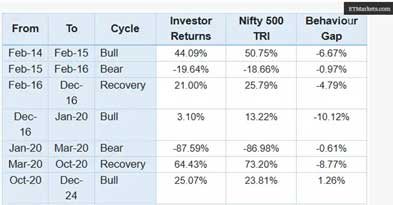“Meri gaadi itni mileage kyun nahin deti?”
If you’ve ever muttered these words while filling petrol, you’ve stumbled upon one of investing’s biggest secrets. And you didn’t even know it.
Your car promises 18 km/litre. You’re getting 12. The gap isn’t a manufacturing defect; it’s your driving style. Similarly, that mutual fund advertising 15% returns while you’re stuck at 8%? Same problem, different vehicle. What’s truly interesting is that few talk about this gap, of how investor behaviour often influences results. Investor behaviour can quietly impact outcomes more than market movements ever do.
What The Data Actually Says
Investor Behaviour Across Market Cycles

The data shows that investors often trail the market during bull phases. For instance, between Feb 2014 – Feb 2015, investors earned approx 44.09% while the Nifty 500 TRI delivered approx 50.75%, creating a -6.67% behaviour gap. A similar trend appeared in the Dec 2016 – Jan 2020 bull run, where investor returns were just 3.10%, far below the market’s 13.22%, reflecting missed opportunities from hesitation or poor timing.
Even during recoveries, investor performance lagged — such as Feb – Dec 2016 and Mar – Oct 2020, where the behaviour gap was -4.79% and -8.77% respectively. These patterns underline how timing mistakes and reactive decision-making erode long-term wealth creation.
So yes, the markets can deliver. But many people don’t capture those returns.
Why The Gap Exists: It’s Not Just About Returns — It’s About Behaviour
Several behavioural patterns consistently erode investor performance. The first is emotional reaction. When markets rise, many feel the urge to double down, and when they fall, the instinct is to exit quickly. Add to that the fear of missing out when friends boast about surging portfolios, and you have a recipe for poor timing, buying high and selling low.
Another common issue is poor discipline and lack of process. Investors often ignore asset allocation, allow a single fund or theme to dominate when it gets “hot,” and fail to rebalance. Many also skip regular reviews to check whether their investments still align with their goals and risk tolerance.
The third behavioural trap is switching too often or chasing trends. Investors move between categories and funds based on recent winners, act reactively instead of strategically, and let short-term noise dictate long-term allocations.
Finally, there’s the problem of neglecting long-term compounding. Compounding is powerful only when left undisturbed over time. Interruptions through frequent exits, fund switching, or premature withdrawals reset the process, leading to diminished results. Studies of Indian investors highlight that, despite growing financial literacy, many still succumb to behavioural biases like overconfidence, herd mentality, loss aversion, and mental accounting. These biases consistently result in sub-optimal timing and poor decision-making.
Even a 3-5% difference per year is massive in the long run. Suppose you expect 11-12% returns (assuming long-term indices deliver), but because of behavioural drift you end up with say 7-8%. Over 15-20 years, that difference compounds into a significantly lower corpus, lakhs of rupees (if not crores) of missed wealth creation.
What Smart Investors Do Differently
You might already understand what good behaviour looks like. Here are practical practices that close the gap:
- Set a clear investment plan: asset mix, goal timeline, risk tolerance.
- Build rules for entry/exit rather than letting fear or greed decide.
- Regularly (say, annually or semi-annually) review & rebalance.
- Ignore short-term hype. Recognise what you can’t predict.
- Ideally, work with someone who adds discipline (advisor, robo-advisor, etc.), someone whose earnings don’t depend on you buying high/selling in panic.
The Uncomfortable Question
If adopting disciplined behaviour could add much more to your future net worth, would you really do it?
Many say yes, but few do. Because real behaviour change requires patience, resisting impulses, and staying consistent over years, even when markets test you. Markets can deliver strong returns. But what you actually walk away with depends heavily on your decisions along the way. The gap isn’t always about faulty funds or bad markets, it’s more about how you invest.
“Markets will give you mileage. But behaviour will decide how much.”

